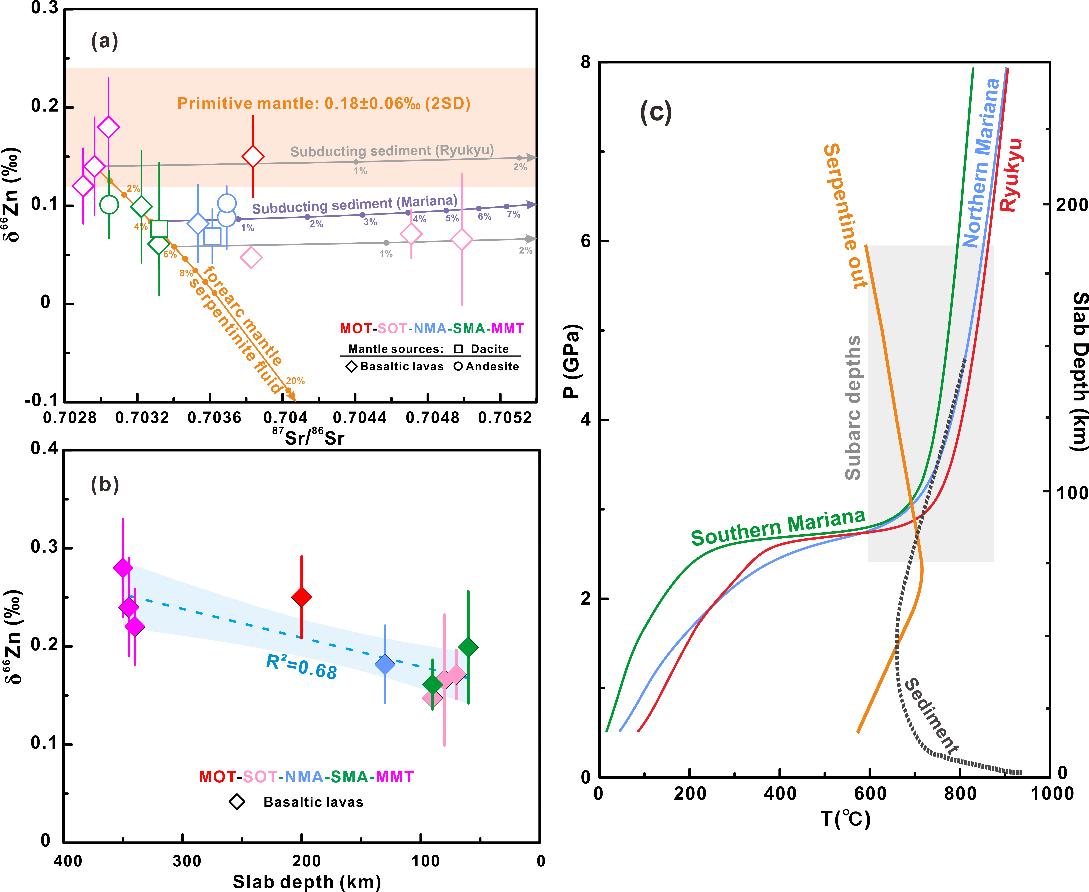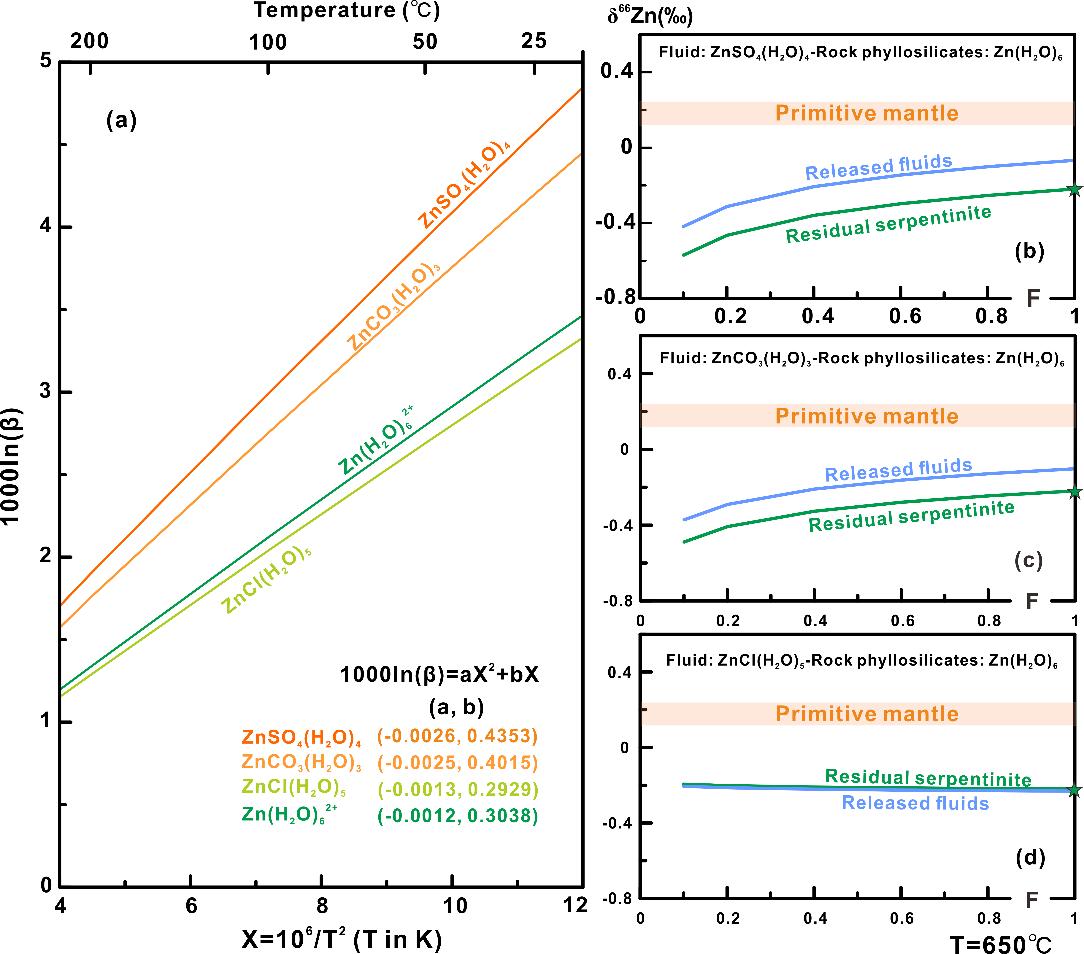Serpentinite, formed by low-temperature hydrothermal alteration of mantle peridotite, is distributed in the lithospheric mantle at the bottom of the subduction slab (slab-serpentinite) and forearc mantle wedge above the subduction slab (mantle wedge serpentinite) in the subduction zone. Since they usually contain a large amount of water (> 13 wt.%), fluid-mobile elements (Cs, Rb, Sr, Ba, Pb, Li, etc.), and heavy B isotopes, applying the traditional geochemical means to distinguish the two different sources of serpentinite-derived fluids in the genesis of arc magmas is challenging.
Recently, the research team led by Zhigang Zeng from Institute of Oceanology, Chinese Academy of Sciences (IOCAS), conducted collaborative research with Prof. Jiubin Chen from Tianjin University. The latest research results on zinc isotopes of subduction-related lavas from the Western Pacific and implications for crust-mantle recycling were published in the Journal of Geophysical Research: Solid Earth (Nature Index), which provided an effective means to distinguish the contributions of slab and mantle wedge serpentinite-derived fluids to arc magmas with important significance for understanding the role of serpentinite in material recycling in subduction zones.
Notably, the arc-related lavas have lower δ66Zn values than those of the mid-ocean ridge basalts (MORB), whereas back-arc lavas display MORB-like δ66Zn values. Moreover, δ66Zn has a good correlation with proxies for fluid addition (87Sr/86Sr and Ba/La) and slab depths (Fig. 1). Since mantle melting and magmatic differentiation respectively induce heavy Zn isotope enrichment in primary and evolved magmas, while melt extraction yields the limited Zn isotope fractionation in the mantle, lavas with low δ66Zn values thus potentially indicate the involvement of isotopically light fluids in their mantle sources.
In contrast to the heavy Zn isotope of the slab serpentinites, the forearc serpentinites are typically characterized by extremely light Zn isotope. Correspondingly, fluids released by forearc serpentinite dehydration have a significantly lower Zn isotopic composition relative to the mantle wedge (Fig. 2).
Therefore, such forearc materials were likely dragged downward to subarc depths and released isotopically light Zn in fluids to modify the overlying mantle wedge (Fig. 3), thereby producing low δ66Zn values in arc-related magmas. Beyond subarc depths, forearc serpentinites are broken down completely, so light Zn isotope fluids are absent. Accordingly, the lavas from the back-arc basin display MORB-like δ66Zn values. It provides conclusive evidence for the hypothesis that forearc mantle wedge serpentinites can be involved in the subduction channel and transported into the subarc depth, and then dehydrate and modify the subarc mantle wedge.
The above research work was supported by the National Natural Science Foundation of China, the Strategic Priority Research Program (B) of Chinese Academy of Sciences, the Shandong Provincial Natural Science Foundation, China, and the Open Fund of the Key Laboratory of Marine Geology and Environment, Chinese Academy of Sciences.

Fig. 1 The relationship between δ66Zn and 87Sr/86Sr and slab depth (a-b); thermal structures of the Mariana and Ryukyu subduction zones compared with serpentinite stability domains (c).

Fig.2 Temperature (T) dependence of reduced partition function ratios (ln(β)) for various aqueous Zn complexes (a); models of the δ66Zn evolution in the dehydrated forearc serpentinite and associated released fluids (b-d).

Fig. 3 Forearc mantle serpentinites can be down-dragged to subarc depths and subsequently release fluids with light Zn isotope compositions to modify subarc mantle wedge.
Zuxing Chen*, Jiubin Chen, Zhigang Zeng*, Landry Soh Tamehe, Ting Zhang, Yuxiang Zhang, Xuebo Yin, Xiaoyuan Wang, Shuai Chen, Wangcai Shuai. Zinc isotopes of the Mariana and Ryukyu arc-related lavas reveal recycling of forearc serpentinites into the subarc mantle. Journal of Geophysical Research: Solid Earth, 2021, 126, e2021JB022261. https://doi.org/10.1029/2021JB022261.
CHEN Zuxing
Institute of Oceanology
E-mail: chenzuxing@qdio.ac.cn
(Editor: ZHANG Yiyi)
|
|

Address: 7 Nanhai Road, Qingdao, Shandong 266071, China
Tel: 86-532-82898902 Fax: 86-532-82898612 E-mail: iocas@qdio.ac.cn


